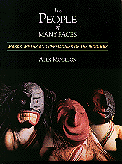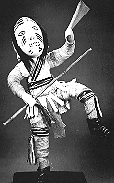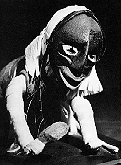


|
The People of Many Faces:
Masks, Myths and Ceremonies of the Iroquois.
Alex Mogelon.
Lakefield, ON: Waapoone Publishing, 1994. 61pp, paper, $15.95.
ISBN 0-9692185-7-5.
Grades 10 - 13 / Ages 14 and Up.
Review by Adele Case.
|
excerpt:
Broken Nose: This is the mask carved most frequently, depicting the Great
Defender after the onrushing mountain had smashed his nose. Usually this
mask is black, perhaps to represent the defeat that had been endured, or
the fact that the mountain had been moved causing Elder Brother The Sun
to cast a shadow. Both masks (Keel Nose and Broken Nose) were usually
required in any ceremony or curing performance, since one is incomplete
without the other.
 The People of Many Faces contains a chronological history
of the Iroquois Five Nations (made up originally of the Cayuga, Mohawk,
Oneida, Onondaga and Seneca tribes from present day New York state).
Theirs was a political and military union. Over a hundred years later,
members of the Tuscarora tribe were allowed to join with the Iroquois,
and a Six Nations group came into being. During the American revolution,
the confederacy came to an end, as a couple of the tribes moved to
Canada, while the remainder continued in their ancestral land.
The People of Many Faces contains a chronological history
of the Iroquois Five Nations (made up originally of the Cayuga, Mohawk,
Oneida, Onondaga and Seneca tribes from present day New York state).
Theirs was a political and military union. Over a hundred years later,
members of the Tuscarora tribe were allowed to join with the Iroquois,
and a Six Nations group came into being. During the American revolution,
the confederacy came to an end, as a couple of the tribes moved to
Canada, while the remainder continued in their ancestral land.
This slim book, written economically -- at times almost tersely --
by Alex Mogelon, contains a lengthy bibliography, and a listing of
museums and historical sites where there are collections of the masks of
the False Face Medicine Society. The author has had a lifetime interest
in, and association with members of the Iroquois tribe, and a number of
the legends were told to him orally by a chief of the Six Nations.
The primary physical structure of the Six Nations was the wooden longhouse, which
served not only to shelter individual clan families, but also as a
gathering place for extended family groupings. Theirs was a matrilineal
society, and clan identification came through a creature name (deer,
hawk, turtle). The society was complex, and various festivals were
celebrated throughout the calendar year. Without a written language, the
festivals were crucial in passing on the tribal history, superstitions,
and religious beliefs. The collective memory was invested in members of
the False Face Medicine Society, and the masks were essential in giving
the myths human-like form that aided members of the tribe to more fully
understand their past, and to bind them into a cohesive group.

Masks were named, and the richness of their culture is evident in
the multiplicity of names, from expressions (Crooked Mouth, Drooping
Mouth, Smiling Mouth, Long Nose) to occupations (Clown, Happy Hunter), to
animals (Bear, Buffalo, Wolf), to feared diseases (Small Pox and
Measles), to masks that showed aspects of the Great Defender myth -- a
complicated explanation that incorporated the creation of the world, and
perhaps humanity's fall from grace. This sense of evil is shown in the
mask called Broken Nose, and another mask (Whirlwind) further
illustrates the damaging power of nature, the dawn and sunset, and the
importance of good weather for crops to grow and mature.
Mogelon also shows the wooden masks which were created after a
member of the tribe had a dream vision. The wood was taken piously from a
growing basswood tree, and the tree had to survive the `donation' of the
fabric of the mask in order for the mask to have ritual power. Other
masks and dolls were made from husks of corn, one of the principal food sources
of the tribes. These lacked the power of the wooden masks, but had
their place in various rituals.
The author closes by repeating the legend of Deganawidah and
Hiawatha. These mythic figures together devised the great peace, code of
law, and other concepts which became the Great Law of the Iroquois
confederacy. This small book contains a wealth of information and should
be included in the library of anyone interested in the Iroquois people.
Recommended.
Adele Case is a high-school teacher who lives in West Vancouver.
To comment on this title or this review, send mail to cmeditor@mts.net

Copyright © 1995 the Manitoba Library Association.
Reproduction for personal use is permitted only if this copyright notice
is maintained. Any other reproduction is prohibited without permission.
Published by
The Manitoba Library Association
ISSN 1201-9364
 Go back to CM Welcome page
Go back to CM Welcome page
 Go back to Table of Contents for this Issue
Go back to Table of Contents for this Issue



 The People of Many Faces contains a chronological history
of the Iroquois Five Nations (made up originally of the Cayuga, Mohawk,
Oneida, Onondaga and Seneca tribes from present day New York state).
Theirs was a political and military union. Over a hundred years later,
members of the Tuscarora tribe were allowed to join with the Iroquois,
and a Six Nations group came into being. During the American revolution,
the confederacy came to an end, as a couple of the tribes moved to
Canada, while the remainder continued in their ancestral land.
The People of Many Faces contains a chronological history
of the Iroquois Five Nations (made up originally of the Cayuga, Mohawk,
Oneida, Onondaga and Seneca tribes from present day New York state).
Theirs was a political and military union. Over a hundred years later,
members of the Tuscarora tribe were allowed to join with the Iroquois,
and a Six Nations group came into being. During the American revolution,
the confederacy came to an end, as a couple of the tribes moved to
Canada, while the remainder continued in their ancestral land.
![]()
 Go back to CM Welcome page
Go back to CM Welcome page Go back to Table of Contents for this Issue
Go back to Table of Contents for this Issue